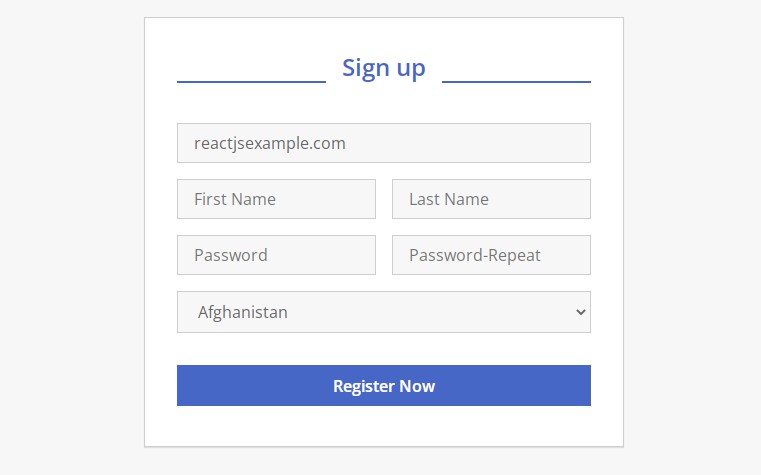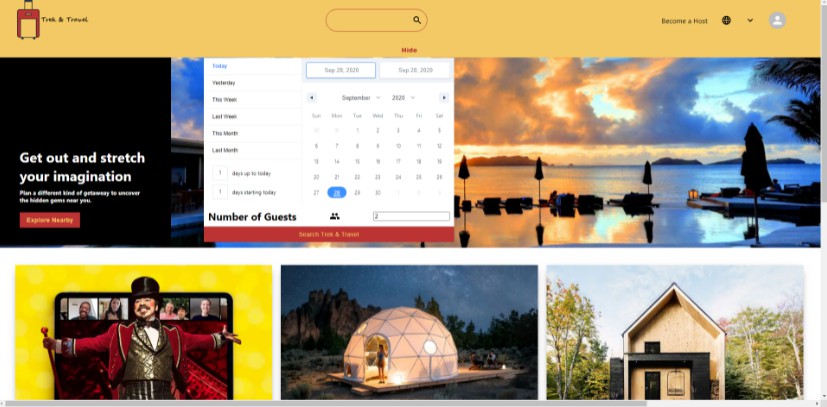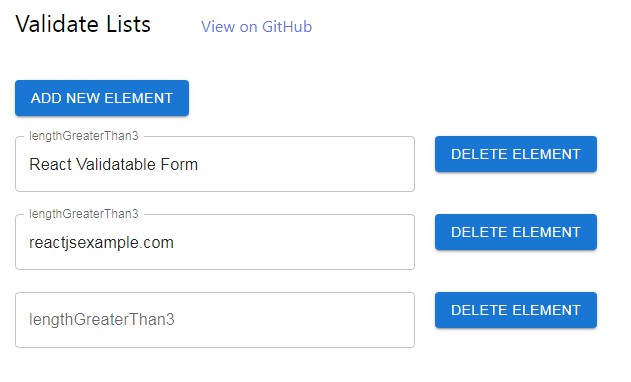Reactjs Forms
Simplify your form validations in React projects with hook and extended html form elements.
Installation
$ npm install reactjs-forms
Guide
reactjs-forms is a React package that contains a few React components and hook system. The components are almost the same as React syntactic form elements.So you may use all attributes which you can use them on syntactic form elements.
Extended Features
reactjs-forms contains Input,Select and Textarea components.that components have validation,customValidation,identity props.Validation prop is a PrimaryValidateObject typed object prop.Validation accepts an object which contains primary validations.(buit-in validations).CustomValidation accepts a function is that returns object.That object has msg and result props.Msg is used to send a msg to ValidationResultObject whenever custom validation result is false.
Primary Validations
| descriptor | is value forced | explanation |
|---|---|---|
| required | No | value cannot be empty or undefined |
| isEmail | No | value must be email address format |
| isAlpha | No | value must contain letters |
| isUnicode | No | value must contain unicode letters |
| isName | No | value must be name format |
| isNumeric | No | value can be numbers |
| isAlphaNumeric | No | value must contain letters and numbers |
| isUnicodeNumeric | No | value must contain unicode letters and numbers |
| maxLen | Yes | value must contain fewer characters than {{value}} |
| minLen | Yes | value must contain more characters than {{value}} |
| max | Yes | value must be numeric that lower than {{value}} |
| min | Yes | value must be numeric that greater than {{value}} |
Primary validations are under development.You can help me to declare new features so you can be collaborator.Additionally you can access primary validation list under core/pipelines.ts
Custom Validations
You may declare custom validations.Custom validations accpet function with 2 parameters value and identity and returns an object that has result and msg props.
we have given an example see Example – 2
Extended Form Element and Multiple Select Element
- Form element has validation results in submit handler via e.currentTarget.validation
- Primitive React Syntactic select elements cannot set values as array.You have to make an effort to get all selected options from HTMLSelectAttibutes but you don’t need it when using reactjs-forms Select Component.So you can access all selected option values via e.target.values see Example – 2
Examples
we have to wrap React compoents with FormValidation Component that contains base context provider
import React from "react";
import ReactDOM from "react-dom";
import App from "./App";
import FormValidation from "reactjs-forms";
ReactDOM.render(
<FormValidation>
<App />
</FormValidation>,
document.getElementById("root")
);
Or if you develope under NextJS;
_app.jsx;
import type { AppProps } from "next/app";
import FormValidation from "reactjs-forms";
function MyApp({ Component, pageProps }) {
return (
<FormValidation>
<Component {...pageProps} />
</FormValidation>
);
}
export default MyApp;
Example – 1
any component;
import { useMemo, useState } from "react";
import { Form, Input, Textarea, useFormValidation } from "reactjs-forms";
const App = () => {
const [email, setEmail] = useState("");
const [name, setName] = useState("");
const [age, setAge] = useState("");
const [address, setAddress] = useState("");
const [errors, setErrors] = useState({});
const [addressErrors, setAddressErrors] = useState({});
const validation = useFormValidation();
const validationForAddress = useFormValidation("address"); //you may send args to get only specific inputs errors like ["adress","email"] or "address","email"
const emailErrors = useMemo(
() =>
errors.email ? errors.email.map((v, i) => <li key={i}>{v.msg}</li>) : [],
[errors]
);
const nameErrors = useMemo(
() =>
errors.name ? errors.name.map((v, i) => <li key={i}>{v.msg}</li>) : [],
[errors]
);
const ageErrors = useMemo(
() =>
errors.age ? errors.age.map((v, i) => <li key={i}>{v.msg}</li>) : [],
[errors]
);
const onlyAddressErrors = useMemo(
() =>
addressErrors.address
? addressErrors.address.map((v, i) => <li key={i}>{v.msg}</li>)
: [],
[addressErrors]
);
return (
<div>
<Form
onSubmit={(e) => {
e.preventDefault();
console.log(e.currentTarget.validation); //we have accessed to the validation results via submit event currentTarget
setErrors(validation()); //get validation errors and set errors state for rendering
}}
>
<label htmlFor="email">Email:</label>
<Input
onChange={(e) => setEmail(e.target.value)}
value={email} //we have to declare value attribute
identity="email" //also we have to declare identity attribute because of that value is used to get validation results
id="email" //
type="email"
validation={{
required: true,
isEmail: true,
}}
/>
{/* list all email erros*/}
<ul>{emailErrors}</ul>
<br />
<label htmlFor="name">Name:</label>
<Input
onChange={(e) => setName(e.target.value)}
value={name}
identity="name"
id="name"
validation={{
isName: {
msg: "custom message", //you may or not declare a custom message
value: true, //you dont have to declare value also
},
}}
/>
{/* list all name erros*/}
<ul>{nameErrors}</ul>
<br />
<label htmlFor="age">Age:</label>
<Input
onChange={(e) => setAge(e.target.value)}
value={age}
identity="age"
id="age"
validation={{
isNumeric: true,
min: 17, //you can assign value or msg like object notation
max: {
value: "120",
msg: "What was that.holy lighten!!!!!",
},
}}
/>
<ul>{ageErrors}</ul>
<br />
<label htmlFor="address">Address:</label>
<br />
<Textarea
onChange={(e) => setAddress(e.target.value)}
value={address}
identity="address"
id="address"
validation={{
required: true,
isUnicode: true,
}}
onBlur={() => {
setAddressErrors(validationForAddress());
}}
/>
<ul>{onlyAddressErrors}</ul>
<button>Send</button>
</Form>
</div>
);
};
export default App;
Example – 2
In this example we will create a custom validator and also we will use a select form element with multiple selected attribute
import { useMemo, useState } from "react";
import { Form, Input, Select, useFormValidation } from "reactjs-forms";
const Other = () => {
const [password, setPassword] = useState("");
const [passwordRepeat, setPasswordRepeat] = useState("");
const [jobs, setJobs] = useState([]);
const [errors, setErrors] = useState({});
const validation = useFormValidation();
const passwordErrors = useMemo(
() =>
errors.password
? errors.password.map((v, i) => <li key={i}>{v.msg}</li>)
: [],
[errors]
);
const passwordRepeatErrors = useMemo(
() =>
errors.passwordRepeat
? errors.passwordRepeat.map((v, i) => <li key={i}>{v.msg}</li>)
: [],
[errors]
);
const jobsErrors = useMemo(
() =>
errors.jobs ? errors.jobs.map((v, i) => <li key={i}>{v.msg}</li>) : [],
[errors]
);
//we have created a custom validator function
function isEqulPasswords(password) {
return function (value, identity) {
return {
msg: "passwords dont match",
result: password === value,
};
};
}
return (
<div>
<Form
onSubmit={(e) => {
e.preventDefault();
setErrors(validation());
}}
>
<label htmlFor="password">Password:</label>
<Input
onChange={(e) => setPassword(e.target.value)}
value={password}
type="password"
identity="password"
id="password"
validation={{
required: true,
}}
/>
<br />
<ul>{passwordErrors}</ul>
<label htmlFor="password-repeat">Password-Repeat:</label>
<Input
onChange={(e) => setPasswordRepeat(e.target.value)}
value={passwordRepeat}
type="password"
identity="passwordRepeat"
id="passwordRepeat"
validation={{
required: true,
}}
customValidation={{
isEqulPasswords: isEqulPasswords(password),
}}
/>
<br />
<ul>{passwordRepeatErrors}</ul>
<label htmlFor="name">Job:</label>
<Select
onChange={(e) => {
setJobs(e.target.values); //we have accessed directly all the selected values and we have set jobs state
}}
identity="jobs"
multiple
value={jobs}
validation={{
isAlpha: true,
}}
>
<option value="1">Fornt-end Developer</option>
<option value="2">Back-end Developer</option>
<option value="3">Pixel Artist</option>
<option value="4">UX Designer</option>
</Select>
<ul>{jobsErrors}</ul>
<button>Send</button>
</Form>
</div>
);
};
export default Other;
For other examples ; Demo
Finally,if you want to ask any question you can join our Discord channel.
Also you can be contributor.




